The ancient Amphipolis tomb in Eastern Macedonia, Greece, is set to open to the public by 2027.
This announcement has been eagerly awaited by historians, archaeologists, and enthusiasts of Greek antiquity worldwide, marking a significant milestone in the ongoing efforts to preserve and showcase the historical site.
Discovered in 2014, the Amphipolis tomb quickly captivated global attention when archaeologist Katerina Peristeri and her team unearthed the monumental entrance to the burial site, revealing two headless sphinxes that sparked a widespread media frenzy.
The discovery, located in the Kasta mound near the village of Mesolakia, has since been the subject of intense study and meticulous restoration efforts, aimed at securing the monument’s stability and preparing it for public access.
Over the past decade, significant progress has been made in transforming the Amphipolis site into a modern archaeological attraction.
The Greek authorities and archaeologists have prioritised preserving the site’s integrity while enhancing its accessibility to visitors from around the world.
The tomb’s excellent condition and architectural significance make it a unique example of ancient Greek craftsmanship, rivalled by few other sites in the country.
Since its discovery, the Amphipolis tomb has been shrouded in mystery, with various theories circulating about its origins and purpose.
However, scientists and experts continue to focus on factual evidence, ensuring that the site’s true historical significance is understood and preserved.
Among the most stunning finds at Amphipolis is a mosaic depicting the abduction of Persephone by Hades, the king of the Underworld in Greek mythology.
The mosaic, featuring a female figure with fiery red hair, has fascinated archaeologists and further deepened the intrigue surrounding the tomb.
The opening of the site, scheduled for late 2027 or early 2028, promises to be a landmark event for both Greece and the global archaeological community.

